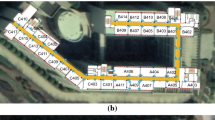Abstract
Utilizing Wi-Fi signals for indoor localization significantly improves location-based services in indoor environments, though challenges arise due to unpredictable Wi-Fi signal propagation. We propose an innovative Feature Enhancement and K-Nearest Neighbor (FEKNN) approach, which refines RSSI data distribution for a more accurate feature database and employs a refined Weighted K-Nearest Neighbor (W-KNN) algorithm to calculate locations by Euclidean distances between enhanced features. Extensive experiments validate that our FEKNN has remarkable accuracy for indoor localization applications, achieving state-of-the-art performance with an impressive average localization error of 1.86 meters on the public UjiIndoorLoc testing dataset, and an average error of 0.68 meters on our custom-built dataset.
Access this chapter
Tax calculation will be finalised at checkout
Purchases are for personal use only
Similar content being viewed by others
References
Zhang, Z., He, S., Shu, Y., Shi, Z.: A self-evolving WIFI-based indoor navigation system using smartphones. IEEE Trans. Mob. Comput. 19(8), 1760–1774 (2020)
Zhuang, Y., Syed, Z., Li, Y., El-Sheimy, N.: Evaluation of two WIFI positioning systems based on autonomous crowdsourcing of handheld devices for indoor navigation. IEEE Trans. Mob. Comput. 15(8), 1982–1995 (2016)
Torres, J., et al.: How feasible is WIFI fingerprint-based indoor positioning for in-home monitoring? In: 2016 12th International Conference on Intelligent Environments (IE), pp. 68–75 (2016)
Li, X., et al.: Indotrack: device-free indoor human tracking with commodity WI-FI. In: Proc. ACM Interact. Mob. Wearable Ubiquitous Technol. 1(3), pp. 1–22 (2017)
Chen, X., Chen, Y., Yu, Q.: Smart home system with bluetooth and WI-FI as communication mode. In: 2021 International Conference on Digital Society and Intelligent Systems (DSInS), pp. 143–147 (2021)
Bellavista-Parent, V., Torres-Sospedra, J., Perez-Navarro, A.: New trends in indoor positioning based on WIFI and machine learning: a systematic review. In: 2021 International Conference on Indoor Positioning and Indoor Navigation (IPIN), pp. 1–8 (2021)
Aydin, H.M., Ali, M.A., Soyak, E.G.: The analysis of feature selection with machine learning for indoor positioning. In: 2021 29th Signal Processing and Communications Applications Conference (SIU), pp. 1–4 (2021)
Hinton, G.E., Salakhutdinov, R.R.: Reducing the dimensionality of data with neural networks. science, 313(5786), 504–507 (2006)
Kingma, D.P., Welling, M.: Auto-encoding variational bayes (2013). arXiv preprint arXiv:1312.6114
Ebaid, E., Navaie, K.: Optimum NN algorithms parameters on the ujiindoorloc for WI-FI fingerprinting indoor positioning systems. In: 2022 32nd International Telecommunication Networks and Applications Conference (ITNAC), pp. 280–286 (2022)
Irsan, F.A.S., Aminah, N.S., Djamal, M.: RSSI - WIFI based indoor position tracking system using support vector machine (SVM). In: 2022 International Conference on Electrical, Computer, Communications and Mechatronics Engineering (ICECCME), pp. 1–5 (2022)
Mittal, A., Tiku, S., Pasricha, S.: Adapting convolutional neural networks for indoor localization with smart mobile devices. In: Proceedings of the 2018 on Great Lakes Symposium on VLSI, GLSVLSI 2018, page 117-122, New York, NY, USA, 2018. Association for Computing Machinery
Torres-Sospedra, J., et al.: Ujiindoorloc: a new multi-building and multi-floor database for WLAN fingerprint-based indoor localization problems. In: 2014 International Conference on Indoor Positioning and Indoor Navigation (IPIN), pp. 261–270 (2014)
Pasricha, S., Ugave, V., Anderson, C.W., Han, Q:. Learnloc: a framework for smart indoor localization with embedded mobile devices. In: 2015 International Conference on Hardware/Software Codesign and System Synthesis (CODES+ISSS), pp. 37–44 (2015)
Adege, A.B., et al.: Applying deep neural network (DNN) for large-scale indoor localization using feed-forward neural network (FFNN) algorithm. In: 2018 IEEE International Conference on Applied System Invention (ICASI), pp. 814–817 (2018)
Chen, T., et al.: Xgboost: extreme gradient boosting. R package version 0.4-2, 1(4), 1–4 (2015)
Krizhevsky, A., Sutskever, I., Hinton, G.E.: Imagenet classification with deep convolutional neural networks. Adv. Neural Inf. Proc. Syst. 25 (2012)
Han, E.H., Karypis, G., Kumar, V.: Text categorization using weight adjusted k-nearest neighbor classification. In: Advances in Knowledge Discovery and Data Mining: 5th Pacific-Asia Conference, PAKDD 2001 Hong Kong, China, April 16–18, 2001 Proceedings 5, pp. 53–65. Springer (2001)
Vaswani, A., et al.: Attention is all you need. Adv. Neural Inf. Proc. Syst. 30 (2017)
Acknowledgements
This work is supported in part by the Beijing Natural Science Foundation L231013, and in part by the National Science Foundation of China (62376271, U21A20515, U22B2034, 62365014, 62262043, and 62171321).
Author information
Authors and Affiliations
Corresponding authors
Editor information
Editors and Affiliations
Rights and permissions
Copyright information
© 2025 The Author(s), under exclusive license to Springer Nature Switzerland AG
About this paper
Cite this paper
Wang, J., Yang, J., Li, B., Meng, W., Zhang, J., Zhang, X. (2025). FEKNN: A Wi-Fi Indoor Localization Method Based on Feature Enhancement and KNN. In: Cai, Z., Takabi, D., Guo, S., Zou, Y. (eds) Wireless Artificial Intelligent Computing Systems and Applications. WASA 2024. Lecture Notes in Computer Science, vol 14997. Springer, Cham. https://doi.org/10.1007/978-3-031-71464-1_1
Download citation
DOI: https://doi.org/10.1007/978-3-031-71464-1_1
Published:
Publisher Name: Springer, Cham
Print ISBN: 978-3-031-71463-4
Online ISBN: 978-3-031-71464-1
eBook Packages: Computer ScienceComputer Science (R0)




